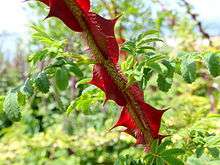Rosa sericea
| Rosa sericea | |
|---|---|
 | |
| Scientific classification | |
| Kingdom: | Plantae |
| (unranked): | Angiosperms |
| (unranked): | Eudicots |
| (unranked): | Rosids |
| Order: | Rosales |
| Family: | Rosaceae |
| Genus: | Rosa |
| Species: | R. sericea |
| Binomial name | |
| Rosa sericea Lindl. | |
Rosa sericea, the silky rose,[1] is a species of Rosa native to southwestern China (Guizhou, Sichuan, Xizang, Yunnan), Bhutan, northern India (Sikkim), Nepal and Myanmar; it grows in mountains at altitudes of 2,000-4,400 m.
It is a shrub growing to 2 m tall, often very spiny. The leaves are deciduous, 4–8 cm long, with 7–11 leaflets with a serrated margin. The flowers are 2.5–5 cm diameter, white, with (unusually for a rose) only four petals. The hips are red, 8–15 mm diameter, with persistent sepals, and often bristly.
There are four formae:
- Rosa sericea f. sericea.
- Rosa sericea f. glandulosa T.T.Yü & T.C.Ku.
- Rosa sericea f. glabrescens Franchet.
- Rosa sericea f. pteracantha Franchet.
The closely related Rosa omeiensis is sometimes treated as a subspecies of R. sericea.
Cultivation and uses
Rosa sericea f. pteracantha is grown as an ornamental plant for its large, bright red thorns.
References
- ↑ "BSBI List 2007". Botanical Society of Britain and Ireland. Archived from the original (xls) on 2015-02-25. Retrieved 2014-10-17.

A shrub of Rosa sericea f. pteracantha

Winged thorn rose detail
| Wikimedia Commons has media related to Rosa sericea. |
This article is issued from Wikipedia - version of the 9/9/2016. The text is available under the Creative Commons Attribution/Share Alike but additional terms may apply for the media files.